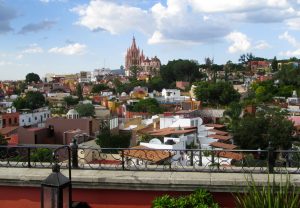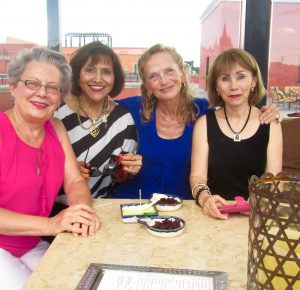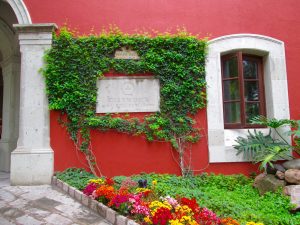Some of my new friends and I have instituted a fun thing to do once or twice a month: Play dress-up (“get dollied up,” as my mother used to say) – complete with heels! — and meet at the luxe Rosewood Hotel here in San Miguel de Allende to enjoy a drink (only one – that’s all we can afford) at their rooftop Luna Bar. “Just to see how the other half lives,” I joke.
I seldom quote my long-dead father, but here I am doing it. He used to pile us kids into his old Hudson convertible on steamy summer evenings in suburban New Jersey and take a breezy drive into upper-crust Bergen County to, as he put it, “see how the other half lives.”
As I wrote as a flashback in my 1981 memoir Somewhere Child (Viking Press): “When the weather was warm we’d drive with the top down – my father at the wheel, my mother in the front seat on the other side, and my younger sisters and I in the back seat, bare-chested and tanned brown, white-blond sun-bleached hair blowing in the warm wind – toward the posher parts of our county. We’d drive slowly past the big houses and their sprawling lawns and play guessing games as to how much each house might be worth, who lived inside, and what it must be like to live there.”
I clearly remember thinking then that I wouldn’t want to live there. The enormous stone mansions looked cold and forbidding to me. They looked un-lived-in and uninviting. Nevertheless, being something of a born anthropologist, I found it fascinating to take a real, live look at this exotic village. My takeaway was that this “other half” was unenviable, uninteresting, and maybe even unhappy.
So why would I care to venture out to the Rosewood Hotel now “to see how the other half lives”? Curiosity, I guess. The Rosewood here in San Miguel is a world-class luxury hotel. (See the Rosewood website: www.rosewoodhotels.com.) One single room, for only one night, costs more than one-month’s rent for my apartment here. One glass of their house red wine costs more than two bottles of my personal favorite Chilean Cabernet Sauvignon-Merlot blend. Walking through their front portal is like walking onto the set of “The Great Gatsby.” You half expect Leonardo DiCaprio to come out from behind a stone pillar, bow and kiss your hand. It’s fun. It’s fantasyland.
Last week, when my friends – all older, divorced, self-supporting women like myself – and I agreed to meet there, I was the first to arrive. I took the elevator to the top floor and was met by the gracious young Mexican hostess at the Luna Bar, who asked for my name and room number.
“Ummm,” I stalled. “I’m not staying here. I’m just visiting.”
She smiled, and, without further questioning, led me to a table under a cloth canopy that faced a zillion-dollar view of the city below. (Forget Leonardo DiCaprio, I thought. I’d rather see this!)

When my friends arrived, we each ordered a glass of wine, which we nursed for two hours, talking, laughing, sharing life stories, and luxuriating in our happiness the whole time.

My takeaway today is that it doesn’t cost much to be happy. Throughout my life – especially when I was a caterer to wealthy people in Manhattan — I’ve crossed paths with the super-rich, and few of them have struck me as particularly happy. In contrast, in my seven years in Africa, I found those with very little (whom Americans would term “poor”) to be among the richest-in-happiness people in the world.
What to make of this? It’s dizzying. How does one square the ever-increasing economic inequality that exists in the so-called “first world” (turning the humorous phrase “the other half” into more like “the top one-to-ten percent”) with the “happiness index”? I read recently that Mexico ranked No. 2 in the “Happy Planet Index,” whereas the USA ranked No. 108 – out of the 140 countries studied. The explanation: “the USA’s material wealth isn’t being translated efficiently into sustainable wellbeing for its residents.” (For more, see: www.happyplanetindex.org.)
Clearly, there are no easy answers. As for me, I’ll keep visiting the village of “the other half” from time to time, just for fun. But I wouldn’t want to live there.

